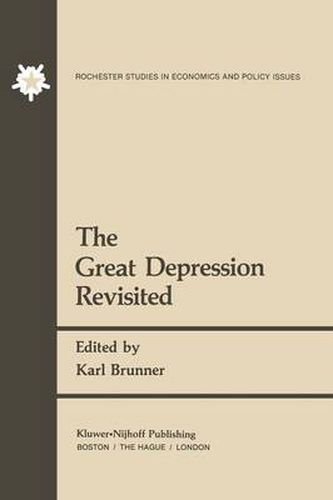Readings Newsletter
Become a Readings Member to make your shopping experience even easier.
Sign in or sign up for free!
You’re not far away from qualifying for FREE standard shipping within Australia
You’ve qualified for FREE standard shipping within Australia
The cart is loading…






This title is printed to order. This book may have been self-published. If so, we cannot guarantee the quality of the content. In the main most books will have gone through the editing process however some may not. We therefore suggest that you be aware of this before ordering this book. If in doubt check either the author or publisher’s details as we are unable to accept any returns unless they are faulty. Please contact us if you have any questions.
The fateful days of the great stock market crash entered modem history almost 50 years ago to this day. The cyclic turning point of the U. S. economy oc curred, however, around June 1929, and economic activity receded substantial ly over the subsequent months. The onset of an economic downswing thus became clearly visible before the famous crash. But the October event stays in the public’s mind as the symbol of the Great Depression. For nearly four years, until the spring of 1933, the U. S. economy plunged into a deep reces sion. Activity declined, prices fell, and there emerged a massive unemploy ment problem. The economy ultimately overcame this shock in 1933. Prices rose rapidly in spite of substantial margins of unusual resources. Activity ex panded, but occasionally at a somewhat hesitant rate. The expansion, however, was interrupted by another recession of major proportions during 1937-38. The tragic sequence of events shaped public consciousness and influenced new approaches and views in economic policymaking. The activist approach to stabilization policy and a wide range of regulatory policies were essentially justified in terms of this experience. These policies were crucially influenced by our understanding and interpretation of the Great Depression. The view of a radically unstable economic process perennially on the edge of serious collapse gained wide popularity and became a central element of the Keynesian tradi- 2 INTRODUCTION tion. It encouraged, with supplementary interpretations, an interventionist and expanding role of the government in our economic affairs.
$9.00 standard shipping within Australia
FREE standard shipping within Australia for orders over $100.00
Express & International shipping calculated at checkout
This title is printed to order. This book may have been self-published. If so, we cannot guarantee the quality of the content. In the main most books will have gone through the editing process however some may not. We therefore suggest that you be aware of this before ordering this book. If in doubt check either the author or publisher’s details as we are unable to accept any returns unless they are faulty. Please contact us if you have any questions.
The fateful days of the great stock market crash entered modem history almost 50 years ago to this day. The cyclic turning point of the U. S. economy oc curred, however, around June 1929, and economic activity receded substantial ly over the subsequent months. The onset of an economic downswing thus became clearly visible before the famous crash. But the October event stays in the public’s mind as the symbol of the Great Depression. For nearly four years, until the spring of 1933, the U. S. economy plunged into a deep reces sion. Activity declined, prices fell, and there emerged a massive unemploy ment problem. The economy ultimately overcame this shock in 1933. Prices rose rapidly in spite of substantial margins of unusual resources. Activity ex panded, but occasionally at a somewhat hesitant rate. The expansion, however, was interrupted by another recession of major proportions during 1937-38. The tragic sequence of events shaped public consciousness and influenced new approaches and views in economic policymaking. The activist approach to stabilization policy and a wide range of regulatory policies were essentially justified in terms of this experience. These policies were crucially influenced by our understanding and interpretation of the Great Depression. The view of a radically unstable economic process perennially on the edge of serious collapse gained wide popularity and became a central element of the Keynesian tradi- 2 INTRODUCTION tion. It encouraged, with supplementary interpretations, an interventionist and expanding role of the government in our economic affairs.